An Investigation of the Damage Mechanism of Multilayer Liquid-Containing Protective Structure under Combined Blast Wave and Fragment Loading
Abstract
:1. Introduction
2. Protective Structure Model and Method
2.1. Protective Structure Model
2.2. Material Model and Parameters
2.3. Numerical Method Verification
3. Results and Discussion
3.1. Structural Damage
3.2. Effect of Charge Mass
3.3. Effect of Fragment Form
3.3.1. Effect of Fragment Weight
3.3.2. Effect of Fragment Number
4. Conclusions
- (1)
- Under combined blast wave and fragment loading, the primary damage modes observed in each layer of the multilayer liquid-containing structure are as follows: A large central punching hole appears on the front plate of the liquid tank, followed by local fragment perforation and bulging bullet marks that extend sequentially from the center to the edge. Simultaneously, the entire structure undergoes substantial deflection deformation. The entire inward deflection deformation and a local fragment gunshot trace are visible on the back plate of the liquid tank. The ceramic layer forms cracks and local fractures. The honeycomb layer deforms as a whole with local collapse fails. The tank has the greatest absorptive capacity, followed by the honeycomb layer, and the front plate sustains the most severe damage. Due to fragments absorbing energy, the shape of the blast wave changes from spherical to ellipsoidal and to apple-shaped, and the water pressure is significantly greater than that of the air.
- (2)
- When all other variables remain constant, the velocity difference between the border fragment and the central fragment increases with increasing charge mass. As the charge mass increases, the explosion wave pressure in the air increases relatively slowly, while the blast wave pressure in the water varies significantly. The damage mode of the multilayer liquid-containing structure is primarily manifested as the expansion of the damage area on the front plate of the liquid tank and as the degree of compression collapse in the honeycomb layer as the charge mass increases. When the charge mass is small, fragments significantly impact the damage mode of the structure. When the equivalent charge mass is large, the damage effect of the blast wave becomes more pronounced.
- (3)
- When the charge mass remains constant, the degree of damage to the protective structure is minimally impacted by the fragment weight. The damage can be substantially reduced by decreasing the number of fragments. The overall plastic energy absorption and damage to the multilayer liquid-containing protective structure decrease as the fragment mass increases. However, the central region of the front plate sustains more severe damage. As the number of fragments increases, the absorption of plastic energy by the structure and the breakage of the front plate of the liquid tank increase significantly.
Author Contributions
Funding
Institutional Review Board Statement
Informed Consent Statement
Data Availability Statement
Conflicts of Interest
References
- Kurki, T. Contained Explosion inside a Naval Vessel—Evaluation of the Structure Response. Master’s Thesis, Helsinki University of Technology, Helsinki, Finland, 2007. [Google Scholar]
- Jiang, L.G.; Zhang, X.D. Destruction Analysis of Broadside Multi-Cabin Protective Structure of Warship under Explosion Loading. In Proceedings of the Advanced Materials and Processes III, Pts 1 and 2; Li, S., Li, W., Li, J., Eds.; University of Science and Technology Liaoning: Anshan, China; Metal Association Liaoning: Shenyang, China; Anshan Iron & Steel Group Corp.: Anshan, China; Saitama Institute of Technology: Saitama, Japan; Nanyang Technological University: Singapore; Chinese University of Hong Kong: Hong Kong, China; National Formosa University: Huwei, Taiwan, 2013; Volume 395–396, pp. 866–870. [Google Scholar]
- Kong, X.; Wu, W.; Li, J.; Chen, P.; Liu, F. Experimental and Numerical Investigation on a Multi-Layer Protective Structure under the Synergistic Effect of Blast and Fragment Loadings. Int. J. Impact Eng. 2014, 65, 146–162. [Google Scholar] [CrossRef]
- Li, M.; Hou, D.; Zhu, H.; Chen, X.; Li, C. Review on Ballistic Impact Resistance of Ship Armor Protection Structure. Ship Build. China 2018, 59, 237–250. (In Chinese) [Google Scholar]
- Palomba, G.; Epasto, G.; Crupi, V. Lightweight Sandwich Structures for Marine Applications: A Review. Mech. Adv. Mater. Struct. 2021, 29, 4839–4864. [Google Scholar] [CrossRef]
- Andreson, C.E., Jr. A Review of Computational Ceramic Armor Modeling. In Advances in Ceramic Armor II: Ceramic Engineering and Science Proceedings; The American Ceramic Society: Westerville, OH, USA, 2006; Volume 27, pp. 1–18. [Google Scholar]
- Hazell, P.J.; Roberson, C.J.; Moutinho, M. The Design of Mosaic Armour: The Influence of Tile Size on Ballistic Performance. Mater. Des. 2008, 29, 1497–1503. [Google Scholar] [CrossRef]
- Serjouei, A.; Gour, G.; Zhang, X.; Idapalapati, S.; Tan, G.E.B. On Improving Ballistic Limit of Bi-Layer Ceramic–Metal Armor. Int. J. Impact Eng. 2017, 105, 54–67. [Google Scholar] [CrossRef]
- Zhu, F.; Zhao, L.; Lu, G.; Wang, Z. Deformation and Failure of Blast-Loaded Metallic Sandwich Panels—Experimental Investigations. Int. J. Impact Eng. 2008, 35, 937–951. [Google Scholar] [CrossRef]
- Wu, X.; Yu, H.; Guo, L.; Zhang, L.; Sun, X.; Chai, Z. Experimental and Numerical Investigation of Static and Fatigue Behaviors of Composites Honeycomb Sandwich Structure. Compos. Struct. 2019, 213, 165–172. [Google Scholar] [CrossRef]
- Wang, G.T.; Ning, Z.H.; Zhao, J.G.; Yang, L.M. Experimental Investigation on Deformation and Failure of Metallic Sandwich Panels under Blast Loading. Mater. Res. Innov. 2011, 15, S98–S101. [Google Scholar] [CrossRef]
- Elanchezhian, C.; Ramnath, B.V.; Ramakrishnan, G.; Raghavendra, K.N.S.; Muralidharan, M.; Kishore, V. Review on Metal Matrix Composites for Marine Applications. Mater. Today Proc. 2018, 5, 1211–1218. [Google Scholar] [CrossRef]
- Deng, Y.; Hu, X.; Yang, X.; Huang, Z.; Wang, Y.; Zhou, C. Dynamic Response of Nomex Honeycomb Sandwich Panels Subjected to Aluminum Foam Projectile Impact–An Experimental Study. Polym. Compos. 2023, 44, 1017–1037. [Google Scholar] [CrossRef]
- Patel, M.; Patel, S. Influence of Honeycomb Core Height on the Blast Mitigation Performance of Sandwich Panel. Mater. Today Proc. 2023, 74, 611–620. [Google Scholar] [CrossRef]
- Townsend, D.; Park, N.; Devall, P.M. Failure of Fluid Dilled Structures Due To High Velocity Fragment Impact. Int. J. Impact Eng. 2003, 29, 723–733. [Google Scholar] [CrossRef]
- Ji, Y.; Li, X.; Zhou, L.; Lan, X. Experimental and Numerical Study on the Cumulative Damage of Water-Filled Containers Impacted by Two Projectiles. Thin-Walled Struct. 2019, 135, 45–64. [Google Scholar] [CrossRef]
- Ren, P.; Shi, L.; Ye, R.; Chai, D.; Zhao, W.; Wu, J.; Zhang, W.; Mu, Z. A Combined Experimental and Numerical Investigation on Projectiles Penetrating into Water-Filled Container. Thin-Walled Struct. 2019, 143, 106230. [Google Scholar] [CrossRef]
- Xu, S.; Zhang, W.; Cai, Y.; Shen, W.; Wu, Y. Study on Anti-Penetration Performance of Kevlar Reinforced Honeycomb Liquid-Filled Cabin on Warship: Experimental Verification and Numerical Analysis. Ocean Eng. 2023, 283, 114959. [Google Scholar] [CrossRef]
- Marchand, K.A.; Vargas, M.M.; Nixon, J.D. The Synergistic Effects of Combined Blast and Fragment Loadings; Southwest Research Institute: San Antonio, TX, USA, 1992. [Google Scholar]
- Nyström, U.; Gylltoft, K. Numerical Studies of the Combined Effects of Blast and Fragment Loading. Int. J. Impact Eng. 2009, 36, 995–1005. [Google Scholar] [CrossRef]
- Zhang, C.; Cheng, Y.; Zhang, P.; Duan, X.; Liu, J.; Li, Y. Numerical Investigation of the Response of I-Core Sandwich Panels Subjected to Combined Blast and Fragment Loading. Eng. Struct. 2017, 151, 459–471. [Google Scholar] [CrossRef]
- Cai, S.; Liu, J.; Zhang, P.; Li, C.; Cheng, Y.; Chen, C. Experimental Study on Failure Mechanisms of Sandwich Panels with Multi-Layered Aluminum Foam/UHMWPE Laminate Core under Combined Blast and Fragments Loading. Thin-Walled Struct. 2021, 159, 107227. [Google Scholar] [CrossRef]
- Li, L.; Jia, F.; Liu, L.; Yu, R.; Zhang, Q.; Li, L. Response of Aluminium Honeycomb Sandwich Panels under Combined Shock and Impact Loading: Experimental and Numerical Investigations. Thin-Walled Struct. 2023, 193, 111256. [Google Scholar] [CrossRef]
- Jin, J.; Hou, H.; Chen, P.; Zhu, X.; Li, D. Experimental Study on the Combined Damage of Liquid Cabin Structure Subjected to Charge Explosion with Preset Fragments. Int. J. Impact Eng. 2019, 130, 19–26. [Google Scholar] [CrossRef]
- Huang, T.; Chen, W.; Peng, S.; Shi, R.; Chai, W.; Li, X. Testing Investigation on Load and Damage Characteristic of Typical Cabins under Warhead Internal Blast. Chin. J. Ship Res. 2023, 19, 1–12. (In Chinese) [Google Scholar] [CrossRef]
- Gupta, Y.M.; Ding, J.L. Impact Load Spreading in Layered Materials and Structures: Concept and Quantitative Measure. Int. J. Impact Eng. 2002, 27, 277–291. [Google Scholar] [CrossRef]
- Tang, H.M.; Tang, R.T.; Wen, H.M. Predicting the Perforation of Ceramic-Faced Light Armors Subjected to Projectile Impact. Int. J. Impact Eng. 2017, 102, 55–61. [Google Scholar] [CrossRef]
- Tao, Y.; Duan, S.; Wen, W.; Pei, Y.; Fang, D. Enhanced Out-of-Plane Crushing Strength and Energy Absorption of In-Plane Graded Honeycombs. Compos. Part B Eng. 2017, 118, 33–40. [Google Scholar] [CrossRef]
- Zhang, Y.; Mao, W.; Yang, L.-W.; Li, K. Dynamic Mechanical Behavior and Constitutive Relation of Shipbuilding E36 Steel. Chuan Bo Li Xue/J. Ship Mech. 2022, 26, 912–918. (In Chinese) [Google Scholar]
- International Symposium on Ballistics; National Defense Industrial Association; International Ballistics Committee. Characterization of Al 6061-T6 Using Split Hopkinson Bar Tests and Numerical Simulations. In Proceedings of the 22nd International Symposium on Ballistics, Vancouver, BC, Canada, 14–18 November 2005; Volume 2. [Google Scholar]
- Feng-Kui, C.; Chao, G.; Yu-Xi, L.I. Flow Stress Characteristics and Dynamic Constitutive Model for 40Cr Steel. J. Henan Univ. Sci. Technol. Nat. Sci. 2012, 5, 1–5. (In Chinese) [Google Scholar]
- Cronin, D.S.; Bui, K.; Kaufmann, C.; Mcintosh, G.; Berstad, T. Implementation and Validation of the Johnson-Holmquist Ceramic Material Model in LS-DYNA. In Proceedings of the 4th European LS-DYNA User’s Conference, Ulm, Germany, 22–23 May 2003. [Google Scholar]
- Luccioni, B.M.; Ambrosini, R.D. Evaluating the Effect of Underground Explosions on Structures. Mecánica Comput. 2008, 25, 1999–2019. [Google Scholar]
- Cheng, D.S.; Hung, C.W.; Pi, S.J. Numerical Simulation of Near-Field Explosion. Tamkang J. Sci. Eng. 2013, 16, 61–67. [Google Scholar]
- Kim, M.-S.; Kim, C.-Y.; Song, M.-K.; Lee, S.S. Assessment of the Blasting Efficiency of a Long and Large-Diameter Uncharged Hole Boring Method in Tunnel Blasting Using 3D Numerical Analysis. Sustainability 2022, 14, 13347. [Google Scholar] [CrossRef]
- Li, J.; Huang, C.; Ma, T.; Huang, X.; Li, W.; Liu, M. Numerical Investigation of Composite Laminate Subjected to Combined Loadings with Blast and Fragments. Compos. Struct. 2019, 214, 335–347. [Google Scholar] [CrossRef]
- LI, S.; LI, X.; Hu, X. Research into Energy Absorption of Liquid Cabin Subjected to Close-Range Explosion. Chin. J. Ship Res. 2017, 12, 101–106. (In Chinese) [Google Scholar] [CrossRef]
- Zhong, Q.; Hou, H.L.; Li, D. Experimental Study on Anti-Penetration Mechanism of Ceramic/Fluid Cabin Composite Structure. Chuan Bo Li Xue/J. Ship Mech. 2017, 21, 1282–1290. [Google Scholar]


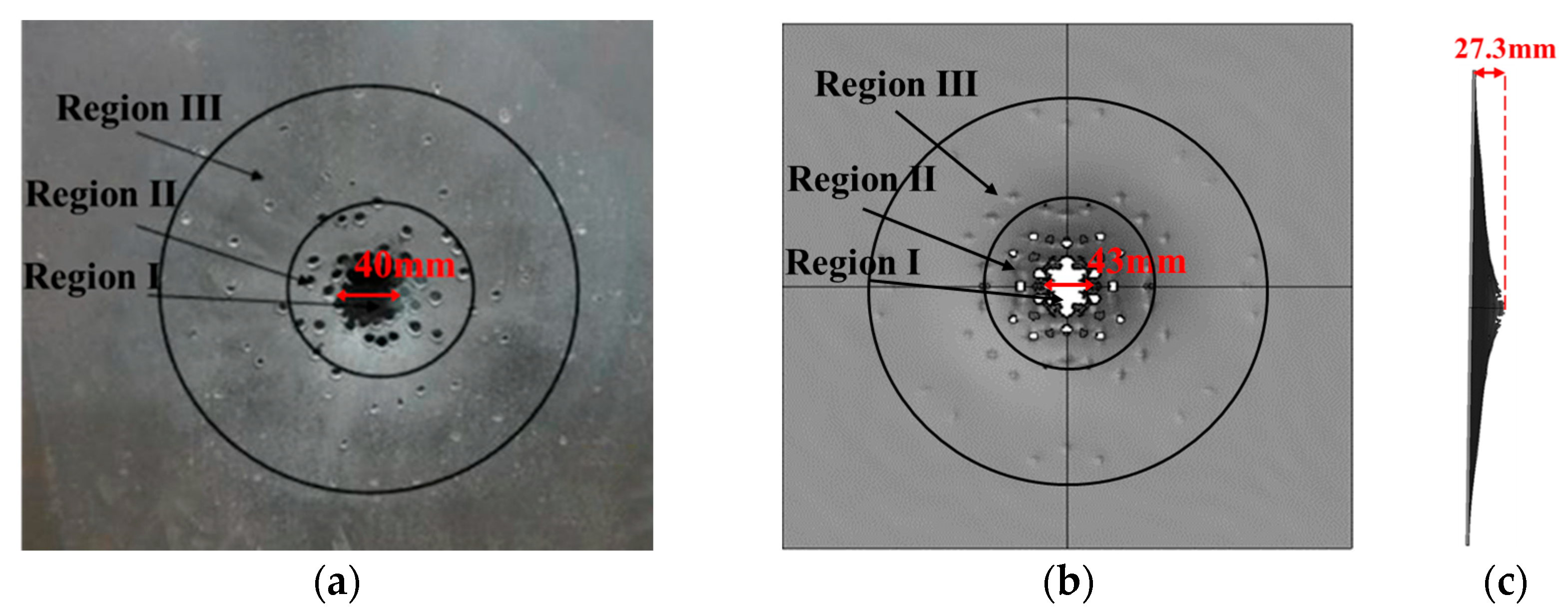
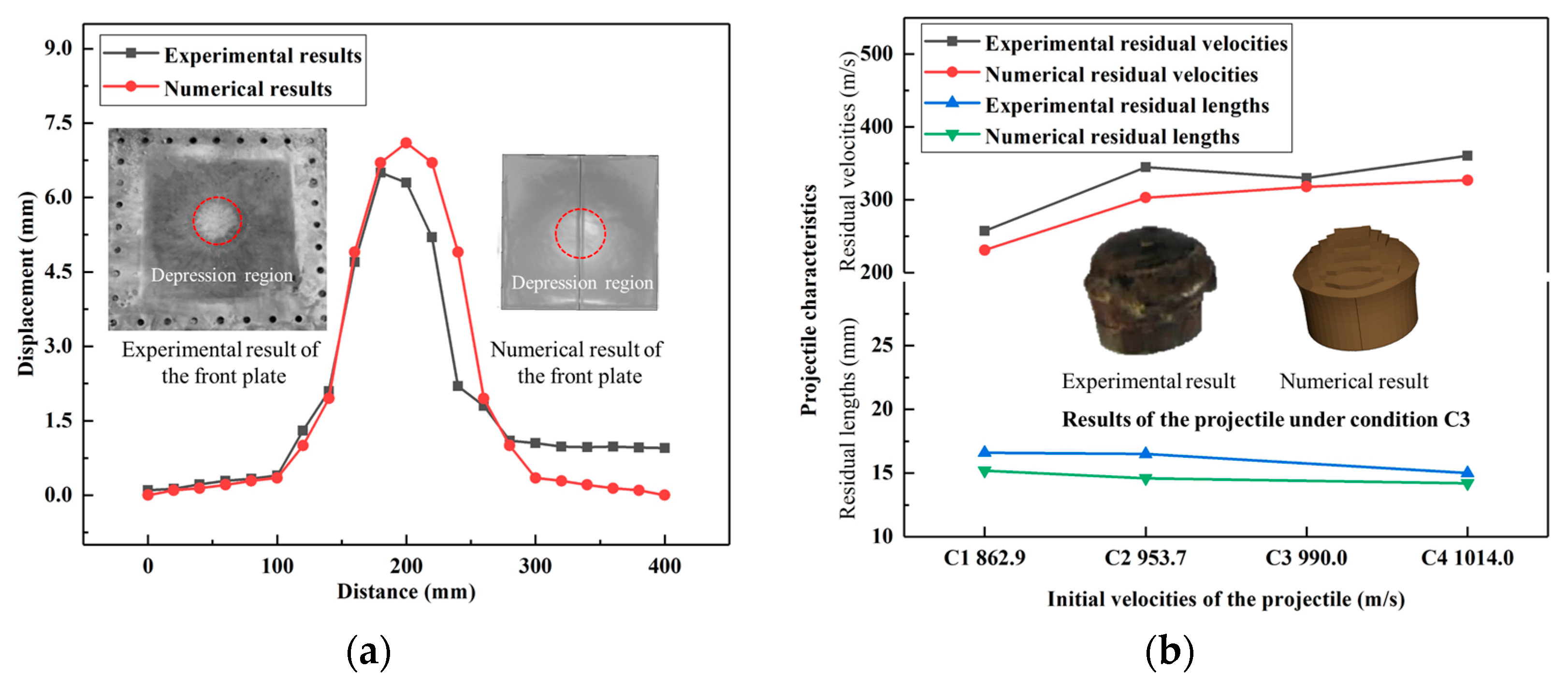
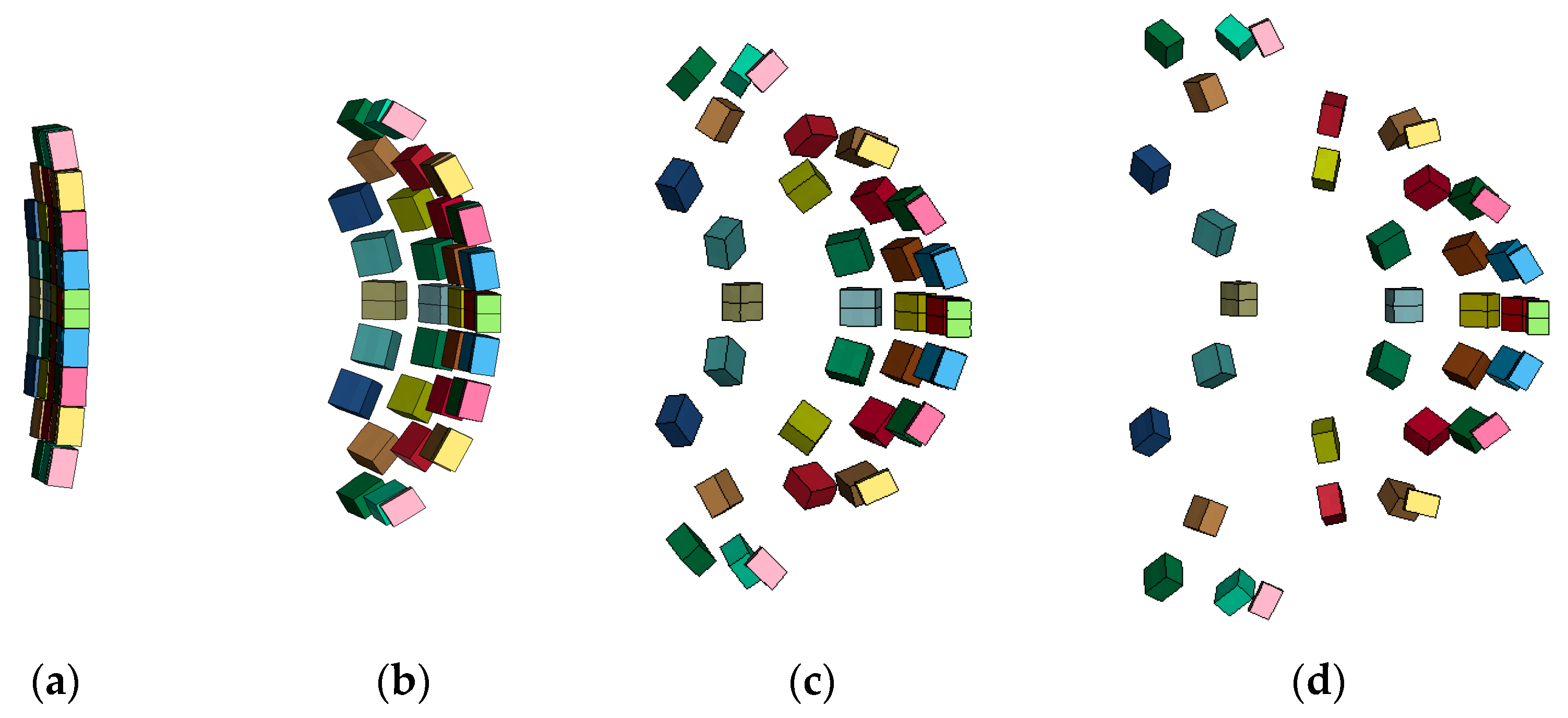
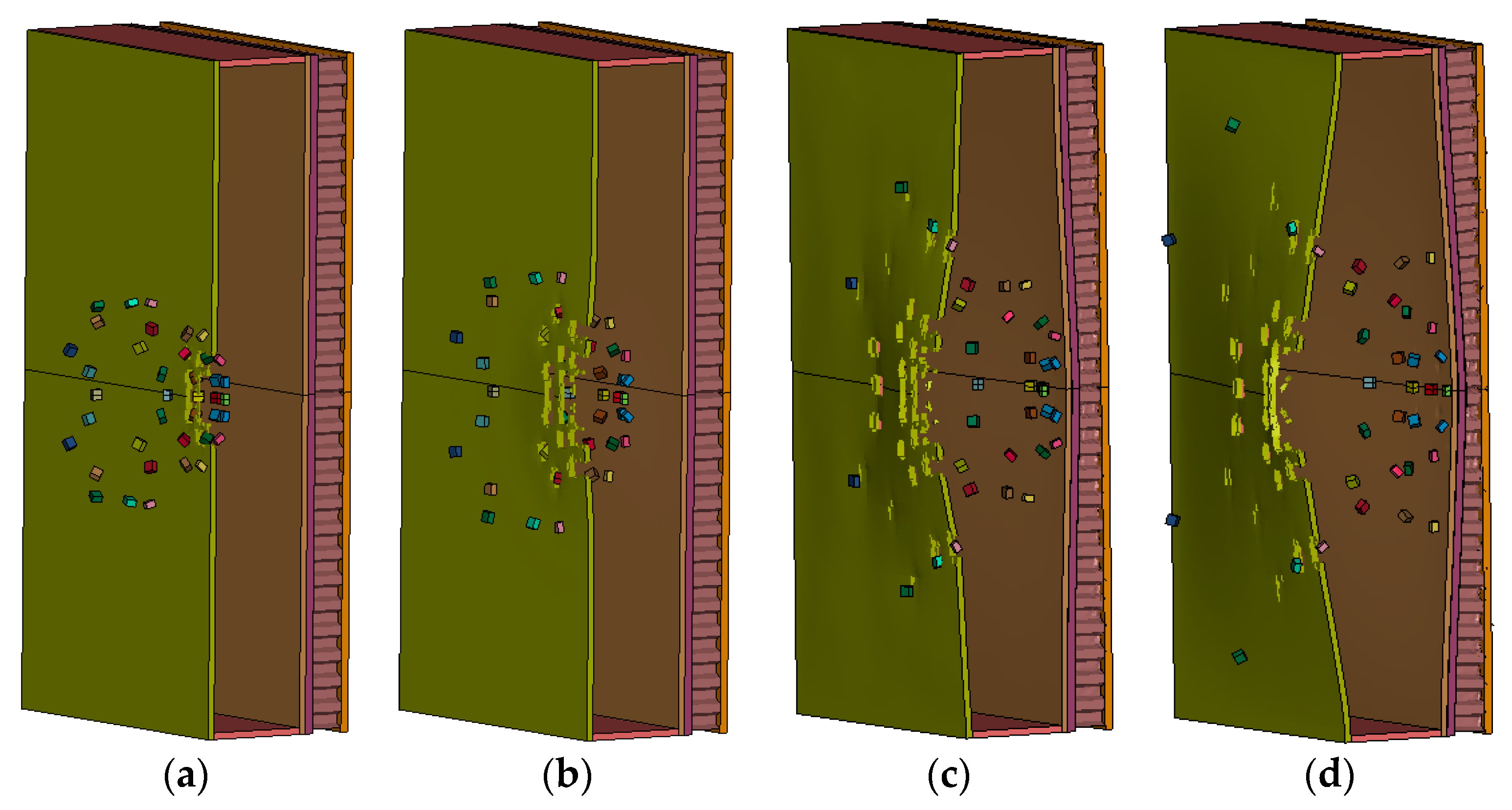

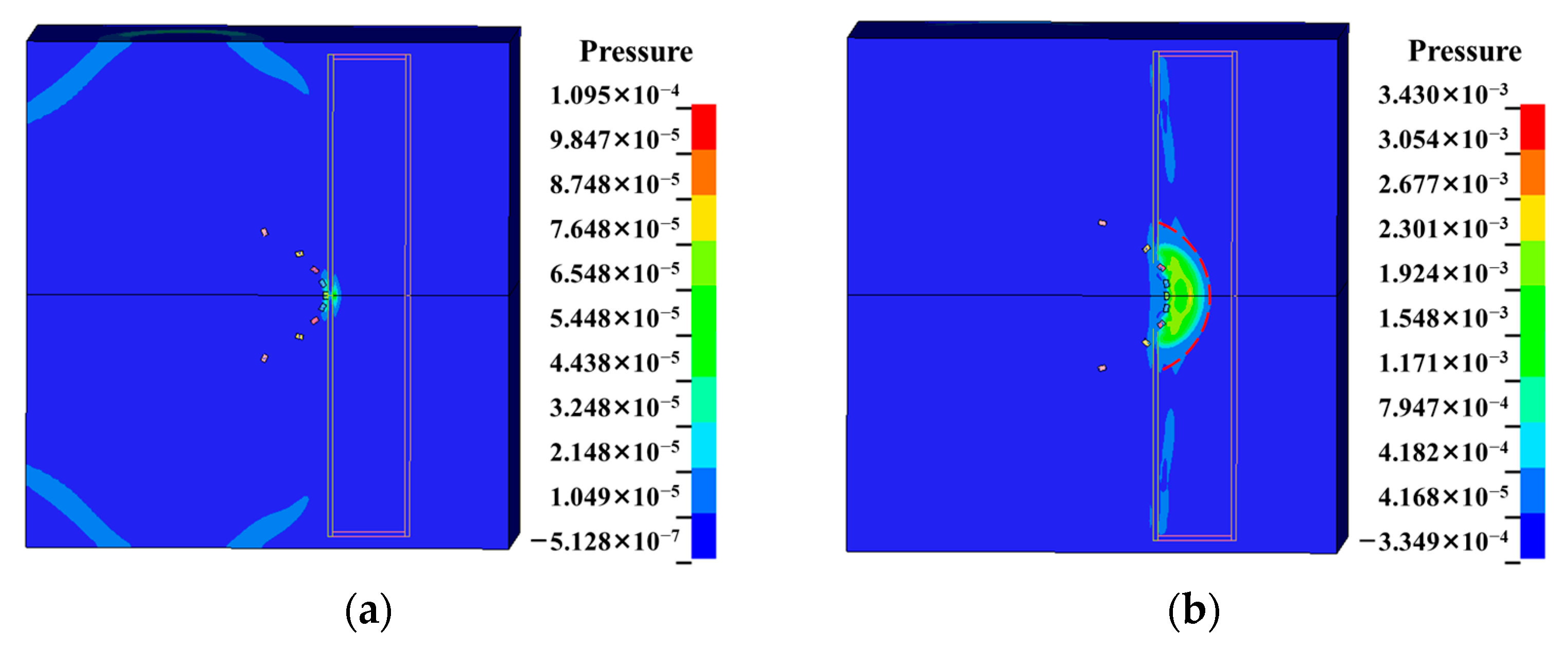
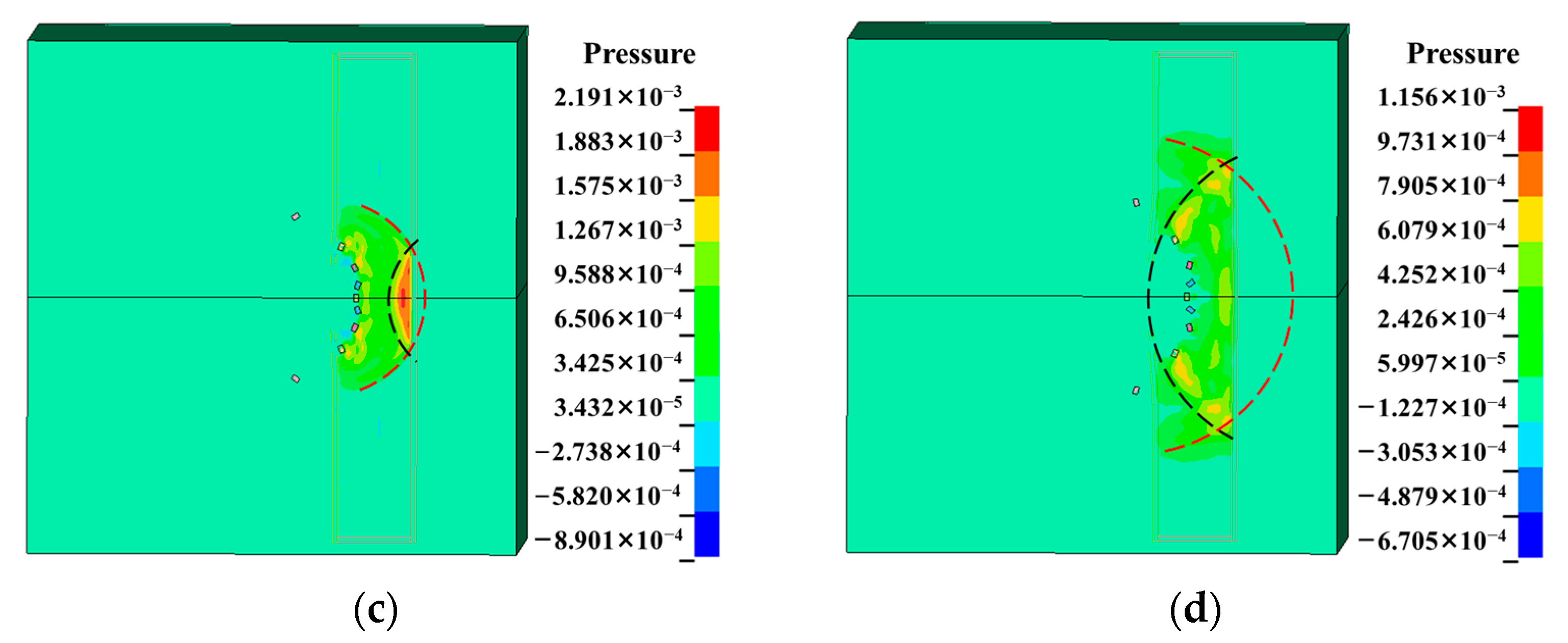

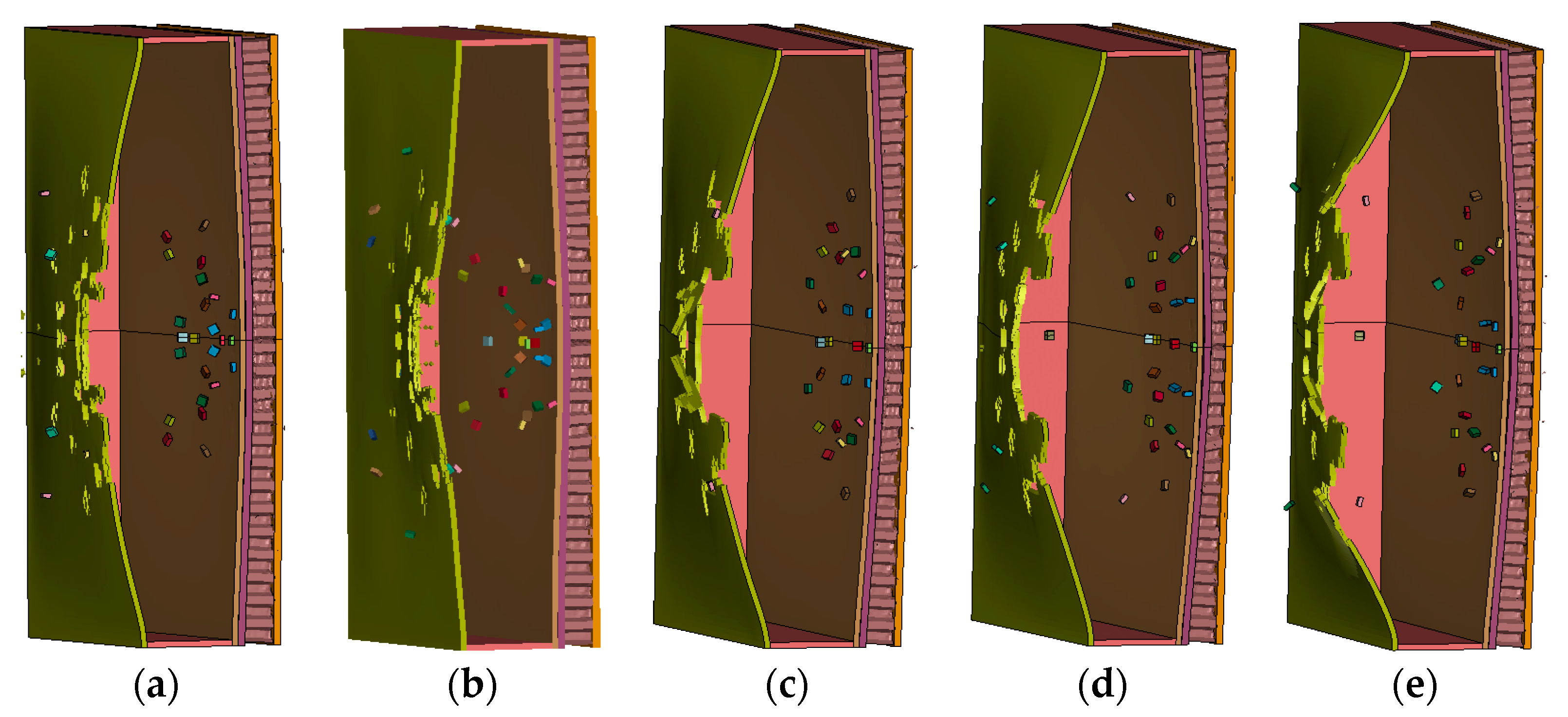

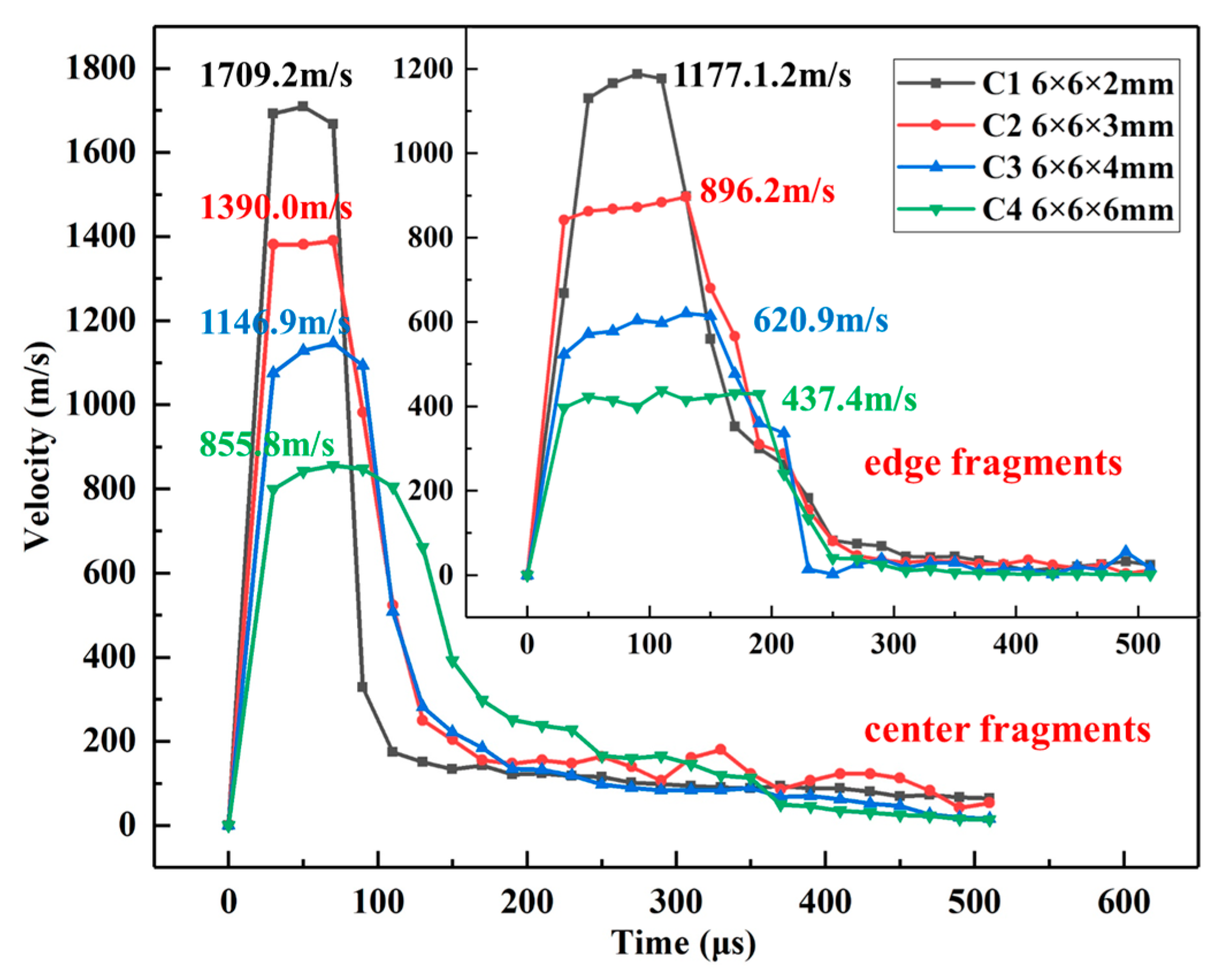

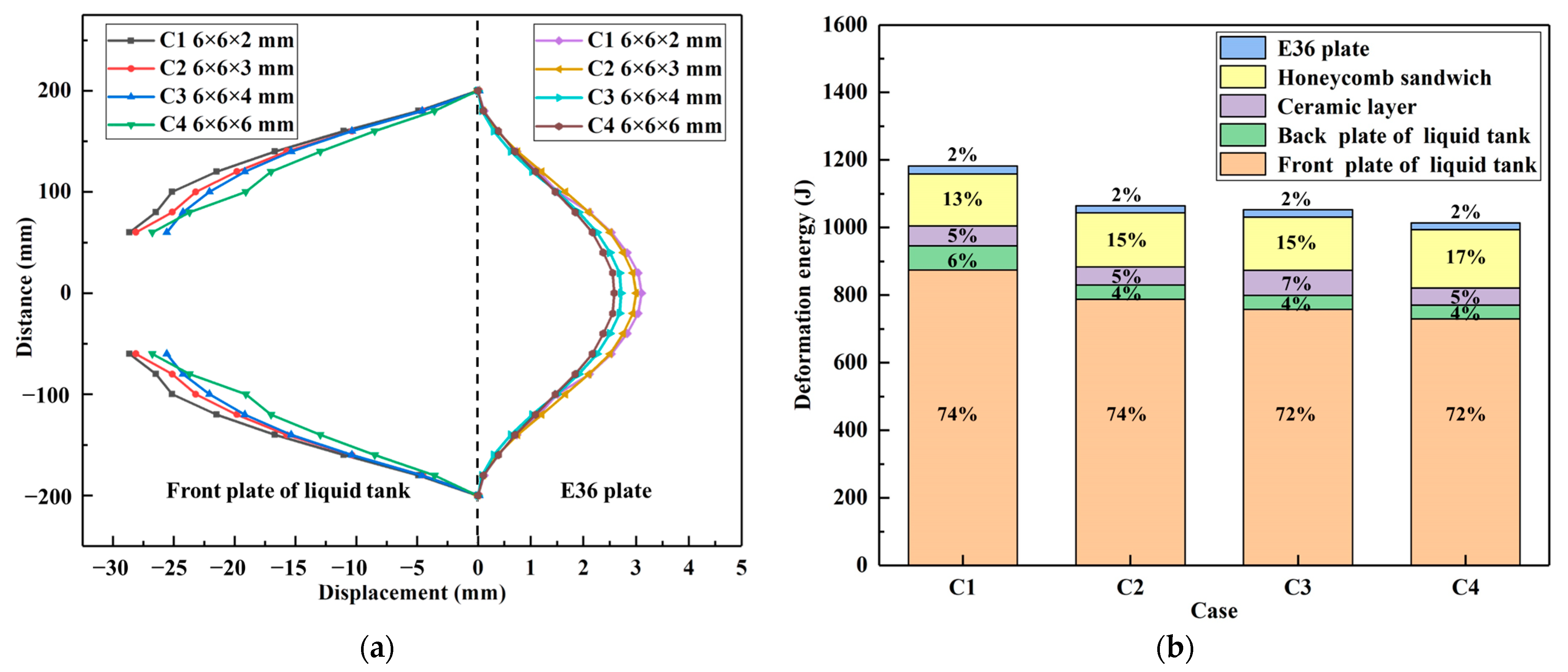
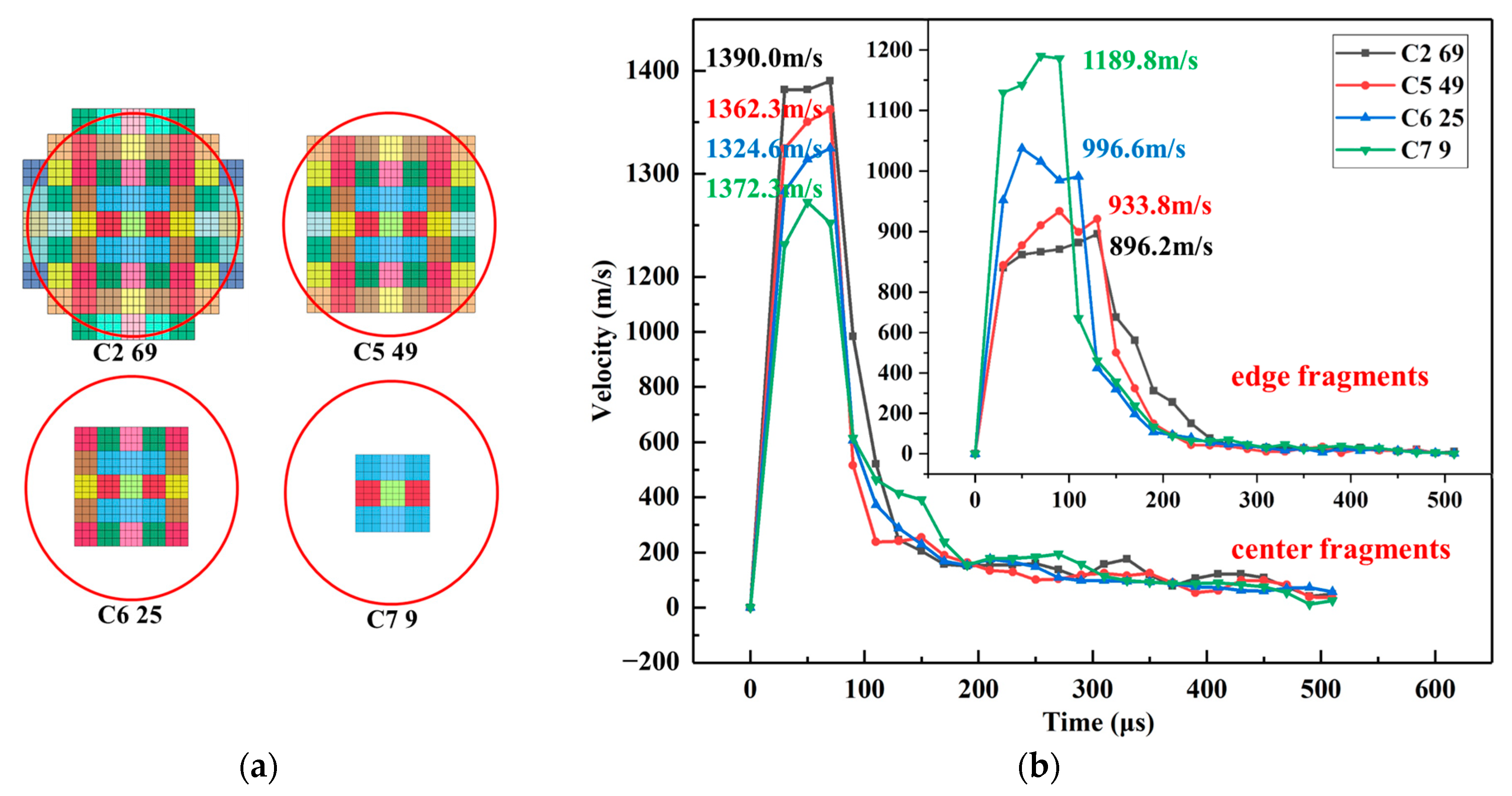


| Material | |||||||
|---|---|---|---|---|---|---|---|
| E36 | 7850 | 209 | 0.295 | 430 | 1 | 5698.7 | 1.92 |
| 6061-T6 | 2704 | 70 | 0.33 | 276 | 1 | 5101 | 1 |
| n | c | m | ||||||||
| 7850 | 205 | 894 | 764 | 0.35 | 0.06 | 1.5 | 1802 | 298 | 0.001 | 0.28 |
| Parameter | Data | Parameter | Data | Parameter | Data | Parameter | Data |
|---|---|---|---|---|---|---|---|
| 3163 | 13.0 | A | 0.96 | EPSI | 1.0 | ||
| 183 | 204.785 | B | 0.35 | BETA | 1.0 | ||
| 0.37 | 0 | C | 0 | 0.48 | |||
| 14.567 | 0 | M | 1.0 | 0.48 | |||
| 5.9 | 0.8 | N | 0.65 | 0 |
| (m/s) | ||||||||
| 1630 | 6930 | 21 | 6.0 | 373.77 | 3.73 | 4.15 | 0.9 | 0.35 |
| Air | Data | Air | Data | Water | Data | Water | Data |
|---|---|---|---|---|---|---|---|
| 1.18 | 0.4 | 998.21 | 0.35 | ||||
| 0 | 0.4 | C/(m/s) | 1647 | 0 | |||
| 0 | 0 | 1.921 | 2.895 × 105 | ||||
| 0 | 2.5 × 105 | −0.096 | 1.0 | ||||
| 0 | 1.0 | 0 |
| Case No. | Fragment Size/mm | Weight of a Single Fragment/g | Number of Fragments |
|---|---|---|---|
| C1 | 6 × 6 × 2 | 0.565 | 69 |
| C2 | 6 × 6 × 3 | 0.848 | 69 |
| C3 | 6 × 6 × 4 | 1.130 | 69 |
| C4 | 6 × 6 × 6 | 1.696 | 69 |
| C5 | 6 × 6 × 3 | 0.848 | 49 |
| C6 | 6 × 6 × 3 | 0.848 | 25 |
| C7 | 6 × 6 × 3 | 0.848 | 9 |
Disclaimer/Publisher’s Note: The statements, opinions and data contained in all publications are solely those of the individual author(s) and contributor(s) and not of MDPI and/or the editor(s). MDPI and/or the editor(s) disclaim responsibility for any injury to people or property resulting from any ideas, methods, instructions or products referred to in the content. |
© 2023 by the authors. Licensee MDPI, Basel, Switzerland. This article is an open access article distributed under the terms and conditions of the Creative Commons Attribution (CC BY) license (https://creativecommons.org/licenses/by/4.0/).
Share and Cite
Fan, Z.; Li, X.; Huang, T.; Chen, W. An Investigation of the Damage Mechanism of Multilayer Liquid-Containing Protective Structure under Combined Blast Wave and Fragment Loading. J. Mar. Sci. Eng. 2023, 11, 2327. https://doi.org/10.3390/jmse11122327
Fan Z, Li X, Huang T, Chen W. An Investigation of the Damage Mechanism of Multilayer Liquid-Containing Protective Structure under Combined Blast Wave and Fragment Loading. Journal of Marine Science and Engineering. 2023; 11(12):2327. https://doi.org/10.3390/jmse11122327
Chicago/Turabian StyleFan, Zeqing, Xiaobin Li, Tao Huang, and Wei Chen. 2023. "An Investigation of the Damage Mechanism of Multilayer Liquid-Containing Protective Structure under Combined Blast Wave and Fragment Loading" Journal of Marine Science and Engineering 11, no. 12: 2327. https://doi.org/10.3390/jmse11122327






